Chapter 7.pmd - welcome main page
Chapter 7.pmd - welcome main page
Chapter 7.pmd - welcome main page
Create successful ePaper yourself
Turn your PDF publications into a flip-book with our unique Google optimized e-Paper software.
BEFORE YOU READActivityDiscuss in class1. What images — of people and of places — come to your mind,when you think of our country?2. What parts of India have you lived in, or visited? Can you namesome popular tourist destinations?3. You may know that apart from the British, the Dutch and theFrench, the Portuguese have also played a part in the history ofour country. Can you say which parts of India show Frenchand Portuguese influences?4. Can you say which parts of India grow (i) tea, (ii) coffee?IA Baker from GoaThis is a pen-portrait of a traditional Goan village baker who stillhas an important place in his society.OUR elders are often heard reminiscing nostalgicallyabout those good old Portuguese days, the Portugueseand their famous loaves of bread. Those eaters of loavesmight have vanished but the makers are still there.We still have amongst us the mixers, the mouldersand those who bake the loaves. Those age-old, timetestedfurnaces still exist. The fire in the furnaceshas not yet been extinguished. The thud and jingle ofreminiscingnostalgicallythinking fondly ofthe past
First Flight86the traditional baker’s bamboo, heralding his arrivalin the morning, can still be heard in some places.Maybe the father is not alive but the son still carrieson the family profession. These bakers are, even today,known as pader in Goa.During our childhood in Goa, the baker used tobe our friend, companion and guide. He used tocome at least twice a day. Once, when he set out inthe morning on his selling round, and then again,when he returned after emptying his huge basket.The jingling thud of his bamboo woke us up fromsleep and we ran to meet and greet him. Why wasit so? Was it for the love of the loaf? Not at all. Theloaves were bought by some Paskine or Bastine,the maid-servant of the house! What we longed forwere those bread-bangles which we chose carefully.Sometimes it was sweet bread of special make.The baker made his musical entry on the scenewith the ‘jhang, jhang’ sound of his specially madebamboo staff. One hand supported the basket onhis head and the other banged the bamboo on theground. He would greet the lady of the house with“Good morning” and then place his basket on thevertical bamboo. We kids would be pushed asidewith a mild rebuke and the loaves would be deliveredto the servant. But we would not give up. We wouldclimb a bench or the parapet and peep into thebasket, somehow. I can still recall the typicalfragrance of those loaves. Loaves for the elders andthe bangles for the children. Then we did not evencare to brush our teeth or wash our mouthsproperly. And why should we? Who would take thetrouble of plucking the mango-leaf for thetoothbrush? And why was it necessary at all? Thetiger never brushed his teeth. Hot tea could washand clean up everything so nicely, after all!heraldingannouncingrebukean expression ofdisapproval; ascoldingfragrancescentOral Comprehension Check1. What are the elders in Goa nostalgic about?2. Is bread-making still popular in Goa? How do you know?3. What is the baker called?4. When would the baker come everyday? Why did the childrenrun to meet him?
Marriage gifts are meaningless without the sweetbread known as the bol, just as a party or a feastloses its charm without bread. Not enough can besaid to show how important a baker can be for avillage. The lady of the house must preparesandwiches on the occasion of her daughter’sengagement. Cakes and bolinhas are a must forChristmas as well as other festivals. Thus, thepresence of the baker’s furnace in the village isabsolutely essential.The baker or bread-seller of those days had apeculiar dress known as the kabai. It was a singlepiecelong frock reaching down to the knees. In ourchildhood we saw bakers wearing a shirt andtrousers which were shorter than full-length onesand longer than half pants. Even today, anyonewho wears a half pant which reaches just belowthe knees invites the comment that he is dressedlike a pader!The baker usually collected his bills at the endof the month. Monthly accounts used to be recordedon some wall in pencil. Baking was indeed aprofitable profession in the old days. The baker andhis family never starved. He, his family and hisservants always looked happy and prosperous. Theirplump physique was an open testimony to this. Eventoday any person with a jackfruit-like physicalappearance is easily compared to a baker.plump physiquepleasantly fat bodyopen testimonypublic statementabout a character orqualityOral Comprehension Check1. Match the following. What is a must(i) as marriage gifts?– cakes and bolinhas(ii) for a party or a feast?– sweet bread called bol(iii) for a daughter’s engagement? – bread(iv) for Christmas?– sandwiches2. What did the bakers wear: (i) in the Portuguese days? (ii) when theauthor was young?3. Who invites the comment — “he is dressed like a pader”? Why?4. Where were the monthly accounts of the baker recorded?5. What does a ‘jackfruit -like appearance’ mean?87Glimpses of India
First Flight881. Which of these statements are correct?(i) The pader was an important person in the village in old times.(ii) Paders still exist in Goan villages.(iii) The paders went away with the Portuguese.(iv) The paders continue to wear a single-piece long frock.(v) Bread and cakes were an integral part of Goan life in the old days.(vi) Traditional bread-baking is still a very profitable business.(vii) Paders and their families starve in the present times.2. Is bread an important part of Goan life? How do you know this?3. Tick the right answer. What is the tone of the author when he says the following?(i) The thud and the jingle of the traditional baker’s bamboo can still beheard in some places. (nostalgic, hopeful, sad)(ii) Maybe the father is not alive but the son still carries on the familyprofession. (nostalgic, hopeful, sad)(iii) I still recall the typical fragrance of those loaves. (nostalgic, hopeful,naughty)(iv) The tiger never brushed his teeth. Hot tea could wash and clean upeverything so nicely, after all. (naughty, angry, funny)(v) Cakes and bolinhas are a must for Christmas as well as other festivals.(sad, hopeful, matter-of-fact)(vi) The baker and his family never starved. They always looked happy andprosperous. (matter-of-fact, hopeful, sad)I. In this extract, the author talks about traditional bread-baking during hischildhood days. Complete the following table with the help of the clues onthe left. Then write a paragraph about the author's childhood days.CluesAuthor’s childhood daysthe way bread was bakedthe way the pader sold breadwhat the pader worewhen the pader was paidhow the pader looked
II. 1.Compare the piece from the text (on the left below) with the other pieceon Goan bakers (on the right). What makes the two texts so different?Are the facts the same? Do both writers give you a picture of the baker?Our elders are often heardreminiscing nostalgically aboutthose good old Portuguese days,the Portuguese and their famousloaves of bread. Those eaters ofloaves might have vanished butthe makers are still there. We stillhave amongst us the mixers, themoulders and those who bake theloaves. Those age-old, time-testedfurnaces still exist. The fire in thefurnaces had not yet beenextinguished. The thud and thejingle of the traditional baker’sbamboo, heralding his arrival inthe morning, can still be heardin some places.May be the father is not alivebut the son still carries on thefamily profession.After Goa’s liberation, people usedto say nostalgically that thePortuguese bread vanished withthe paders. But the paders havemanaged to survive because theyhave perfected the art of door-todoordelivery service. The paderspick up the knowledge of breadmakingfrom traditions in thefamily. The leavened, oven-bakedbread is a gift of the Portugueseto India.[Adapted from NandakumarKamat’s ‘The Unsung Lives of GoanPaders’]892. Now find a travel brochure about a place you have visited. Look at thedescription in the brochure. Then write your own account, adding detailsfrom your own experience, to give the reader a picture of the place, ratherthan an impersonal, factual description.1. In groups, collect information on how bakeries bake bread now and how theprocess has changed over time.2. There are a number of craft-based professions which are dying out. Pick oneof the crafts below. Make a group presentation to the class about the skillsrequired, and the possible reasons for the decline of the craft. Can youthink of ways to revive these crafts?(i) Pottery(v) Carpentry(ii) Batik work(vi) Bamboo weaving(iii) Dhurri (rug) weaving(vii) Making jute products(iv) Embroidery(viii) HandloomGlimpses of India
IICoorgCoorg is coffee country, famous for its rainforests and spices.First Flight90MIDWAY between Mysore and the coastal town ofMangalore sits a piece of heaven that must havedrifted from the kingdom of god. This land of rollinghills is inhabited by a proud race of martial men,beautiful women and wild creatures.Coorg, or Kodagu, the smallest district ofKarnataka, is home to evergreen rainforests, spicesand coffee plantations. Evergreen rainforests coverthirty per cent of this district. During the monsoons,it pours enough to keep many visitors away. Theseason of joy commences from September andcontinues till March. The weather is perfect, withsome showers thrown in forgood measure. The airbreathes of invigoratingcoffee. Coffee estates andcolonial bungalows standtucked under tree canopiesin prime corners.The fiercely independentpeople of Coorg are possiblyof Greek or Arabic descent.As one story goes, a part ofAlexander’s army movedsouth along the coast andsettled here when returnbecame impractical. Thesepeople married amongst thelocals and their culture isapparent in the martialtraditions, marriage andreligious rites, which aredistinct from the Hindu<strong>main</strong>stream. The theory ofArab origin draws supportTraditional Coorgi dress from the long, black coatdrifted frombeen carried alonggently by airmartialhaving to do withwarcanopiesroof-like coveringsthat form sheltersprimehere, best<strong>main</strong>streama tradition whichmost people follow
with an embroidered waist-belt worn by the Kodavus.Known as kuppia, it resembles the kuffia worn bythe Arabs and the Kurds.Coorgi homes have a tradition of hospitality, andthey are more than willing to recount numeroustales of valour related to their sons and fathers.The Coorg Regiment is one of the most decorated inthe Indian Army, and the first Chief of the IndianArmy, General Cariappa, was a Coorgi. Even now,Kodavus are the only people in India permitted tocarry firearms without a licence.The river, Kaveri, obtains its water from the hillsand forests of Coorg. Mahaseer — a large freshwaterfish — abound in these waters. Kingfishers dive fortheir catch, while squirrels and langurs droppartially eaten fruit for the mischief of enjoying thesplash and the ripple effect in the clear water.Elephants enjoy being bathed and scrubbed in theriver by their mahouts.The most laidback individuals become convertsto the life of high-energy adventure with river rafting,canoeing, rappelling, rock climbing and mountaintales of valourstories of courageand bravery, usuallyin warmost decoratedhaving received themaximum numberof awards forbravery in warlaidbackrelaxed; not in a hurryraftingtravelling in a riverin a raft ( a floatingplatform made bytying plankstogether)canoeingtravelling in a riverin a canoe (a large,narrow boat)rappellinggoing down a cliff bysliding down a rope91Glimpses of IndiaBasket-seller from Coorg
iking. Numerous walking trails in this region area favourite with trekkers.Birds, bees and butterflies are there to give youcompany. Macaques, Malabar squirrels, langurs andslender loris keep a watchful eye from the tree canopy.I do, however, prefer to step aside for wild elephants.The climb to the Brahmagiri hills brings youinto a panoramic view of the entire misty landscapeof Coorg. A walk across the rope bridge leads to thesixty-four-acre island of Nisargadhama. Runninginto Buddhist monks from India’s largest Tibetansettlement, at nearby Bylakuppe, is a bonus. Themonks, in red, ochre and yellow robes, are amongstthe many surprises that wait to be discovered byvisitors searching for the heart and soul of India,right here in Coorg.trailspaths created bywalkingpanoramic viewa view of a widearea of landFirst Flight92FACT FILEHow to ReachMadikeri, the district headquarters, is the only gateway to Coorg. The mistyhills, lush forests and coffee plantations will cast a spell on you. Find aresort, coffee estate or stay in a home for a truly Coorgi experience.By Air: The nearest airports are Mangalore (135 km) and Bangalore (260km). There are flights to Mangalore from Mumbai, and to Bangalore fromAhmedabad, Chennai, Delhi, Goa, Hyderabad, Kochi, Kolkata, Mumbai andPune.By Rail: The nearest railheads are at Mysore, Mangalore and Hassan.By Road: There are two routes to Coorg from Bangalore. Both are almostthe same distance (around 250-260 km). The route via Mysore is the mostfrequented one. The other route is via Neelamangal, Kunigal,Chanrayanapatna.1. Where is Coorg?2. What is the story about the Kodavu people’s descent?3. What are some of the things you now know about(i) the people of Coorg?(ii) the <strong>main</strong> crop of Coorg?(iii) the sports it offers to tourists?
(iv) the animals you are likely to see in Coorg?(v) its distance from Bangalore, and how to get there?4. Here are six sentences with some words in italics. Find phrases from thetext that have the same meaning. (Look in the paragraphs indicated)(i) During monsoons it rains so heavily that tourists do not visit Coorg. (para 2)(ii) Some people say that Alexander’s army moved south along the coastand settled there. (para 3)(iii) The Coorg people are always ready to tell stories of their sons’ and fathers’valour. (para 4)(iv) Even people who normally lead an easy and slow life get smitten by thehigh-energy adventure sports of Coorg. (para 6)(v) The theory of the Arab origin is supported by the long coat withembroidered waist-belt they wear. (para 3)(vi) Macaques, Malabar squirrels observe you carefully from the tree canopy.(para 7)CollocationsCertain words ‘go together’. Such ‘word friends’ are called collocations. Thecollocation of a word is ‘the company it keeps’.For example, look at the paired sentences and phrases below. Which is a commoncollocation, and which one is odd? Strike out the odd sentence or phrase.(a) • ‘How old are you?’(b) • a pleasant person• ‘How young are you?’• a pleasant pillow1. Here are some nouns from the text.93culture monks surprise experience weather traditionWork with a partner and discuss which of the nouns can collocate withwhich of the adjectives given below. The first one has been done for you.unique terrible unforgettable serious ancient wide sudden(i) culture:unique culture, ancient cultureGlimpses of India(ii) monks:(iii) surprise:(iv) experience:(v) weather:(vi) tradition
2. Complete the following phrases from the text. For each phrase, can youfind at least one other word that would fit into the blank?(i) tales of(iii) a piece of(ii) coastal(iv) evergreen(v) plantations (vi) bridge(vii) wildYou may add your own examples to this list.IIITea from AssamFirst Flight94Pranjol, a youngster from Assam, is Rajvir’s classmate at schoolin Delhi. Pranjol’s father is the manager of a tea-garden in UpperAssam and Pranjol has invited Rajvir to visit his home during thesummer vacation.“CHAI-GARAM... garam-chai,” a vendor called out in ahigh-pitched voice.He came up to their window and asked,”Chai, sa’ab?”“Give us two cups,” Pranjol said.They sipped the steaming hot liquid. Almosteveryone in their compartment was drinking tea too.“Do you know that over eighty crore cups of teaare drunk every day throughout the world?” Rajvir said.“Whew!” exclaimed Pranjol. “Tea really is verypopular.”The train pulled out of the station. Pranjol buriedhis nose in his detective book again. Rajvir too wasan ardent fan of detective stories, but at the momenthe was keener on looking at the beautiful scenery.It was green, green everywhere. Rajvir had neverseen so much greenery before. Then the soft greenpaddy fields gave way to tea bushes.It was a magnificent view. Against the backdropof densely wooded hills a sea of tea bushes stretchedas far as the eye could see. Dwarfing the tiny teaplants were tall sturdy shade-trees and amidst theorderly rows of bushes busily moved doll-like figures.
In the distance was an ugly building with smokebillowing out of tall chimneys.“Hey, a tea garden!” Rajvir cried excitedly.Pranjol, who had been born and brought up ona plantation, didn’t share Rajvir’s excitement.“Oh, this is tea country now,” he said. “Assam hasthe largest concentration of plantations in the world.You will see enough gardens to last you a lifetime!”“I have been reading as much as I could abouttea,” Rajvir said. “No one really knows whodiscovered tea but there are many legends.”“What legends?”“Well, there’s the one about the Chinese emperorwho always boiled water before drinking it. Oneday a few leaves of the twigs burning under the potfell into the water giving it a delicious flavour. It issaid they were tea leaves.”“Tell me another!” scoffed Pranjol.“We have an Indian legend too. Bodhidharma, anancient Buddhist ascetic, cut off his eyelids becausehe felt sleepy during meditations. Ten tea plantsgrew out of the eyelids. The leaves of these plantswhen put in hot water and drunk banished sleep.“Tea was first drunk in China,” Rajvir added,“as far back as 2700 B.C.! In fact words such astea, ‘chai’ and ‘chini’ are from Chinese. Tea came toEurope only in the sixteenth century and was drunkmore as medicine than as beverage.”The train clattered into Mariani junction. Theboys collected their luggage and pushed their wayto the crowded platform.Pranjol’s parents were waiting for them.Soon they were driving towards Dhekiabari, thetea-garden managed by Pranjol’s father.An hour later the car veered sharply off the <strong>main</strong>road. They crossed a cattle-bridge and enteredDhekiabari Tea Estate.On both sides of the gravel-road were acre uponacre of tea bushes, all neatly pruned to the sameheight. Groups of tea-pluckers, with bamboo basketson their backs, wearing plastic aprons, wereplucking the newly sprouted leaves.95Glimpses of India
Pranjol’s father slowed down to allow a tractor,pulling a trailer-load of tea leaves, to pass.“This is the second-flush or sprouting period,isn’t it, Mr Barua?” Rajvir asked. “It lasts from Mayto July and yields the best tea.”“You seem to have done your homework beforecoming,” Pranjol’s father said in surprise.“Yes, Mr Barua,” Rajvir admitted. “But I hope tolearn much more while I’m here.”I. 1. Look at these words: upkeep, downpour, undergo, dropout, walk-in. Theyare built up from a verb (keep, pour, go, drop, walk) and an adverb or aparticle (up, down, under, out, in).First FlightUse these words appropriately in the sentences below. You may consulta dictionary.(i) A heavyhas been forecast due to low pressure in theBay of Bengal.(ii) Rakesh willmajor surgery tomorrow morning.96(iii) My brother is responsible for the(iv) Theof our family property.rate for this accountancy course is very high.(v) She went to the Enterprise Company to attend ainterview.2. Now fill in the blanks in the sentences given below by combining theverb given in brackets with one of the words from the box as appropriate.over by through out up down(i) The Army attempted unsuccessfully to(throw)(ii) Scientists are on the brink of a major(break)(iii) The State Government plans to build ato speed up traffic on the <strong>main</strong> highway. (pass)the Government.in cancer research.for Bhubaneswar(iv) Gautama’son life changed when he realised that the worldis full of sorrow. (look)(v) Rakesh seemed unusuallyafter the game. (cast)
II. Notice how these -ing and -ed adjectives are used.(a) Chess is an interesting game. I am very interested in chess.(b) Going trekking in the Himalayas We are very excited about thethis summer is an exciting idea. trek.(c) Are all your school books this He was bored as he had noboring?friends there.The -ing adjectives show the qualities that chess, trekking, or these bookshave: they cause interest, excitement, or boredom in you. The —ed/—enadjectives show your mental state, or your physical state: how you feel inresponse to ideas, events or things.1. Think of suitable -ing or -ed adjectives to answer the followingquestions. You may also use words from those given above.How would you describe(i) a good detective serial on television?(ii) a debate on your favourite topic ‘Homework Should Be Banned’?(iii) how you feel when you stay indoors due to incessant rain?(iv) how you feel when you open a present?(v) how you feel when you watch your favourite programme ontelevision?(vi) the look on your mother’s face as you waited in a queue?97(vii) how you feel when tracking a tiger in a tiger reserve forest?(viii) the story you have recently read, or a film you have seen?2. Now use the adjectives in the exercise above, as appropriate, to writea paragraph about Coorg.Glimpses of India1. Read the following passage about tea.India and tea are so intertwined together that life without the brew isunimaginable. Tea entered our life only in the mid-nineteenth centurywhen the British started plantations in Assam and Darjeeling! In thebeginning though, Indians shunned the drink as they thought it was apoison that led to umpteen diseases. Ironically, tea colonised Britainwhere it became a part of their social diary and also led to theestablishment of numerous tea houses.
Today, scientific research across the world has attempted to establishthe beneficial qualities of tea — a fact the Japanese and the Chineseknew anyway from ancient times, attributing to it numerous medicinalproperties.[Source: ‘History: Tea Anytime’ by Ranjit Biswas fromLiterary Review, The Hindu, 1 October 2006]Collect information about tea, e.g. its evolution as a drink, its beneficialqualities. You can consult an encyclopedia or visit Internet websites. Thenform groups of five and play the following roles: Imagine a meeting of a teaplanter, a sales agent, a tea lover (consumer), a physician and a tea-shopowner. Each person in the group has to put forward his/her views abouttea. You may use the following words and phrases.• I feel ... • It is important to know ...• I disagree with you ... • I think that tea ...• I would like you to know ... • I agree with ...• It is my feeling ... • I suggest ...• May I know why you ... • I am afraid ...First Flight2. You are the sales executive of a famous tea company and you have been askedto draft an advertisement for the product. Draft the advertisement using theinformation you collected for the role play. You can draw pictures or addphotographs and make your advertisement colourful.98WHAT WE HAVE DONEGiven a picture of three different regions of India, giving an idea of how varied andcharming and beautiful our country is.WHAT YOU CAN DOGet your students to arrange an exhibition of photographs of different places in India— good sources are travel articles in Sunday newspapers, or in travel magazines, or inbrochures available at travel agents. Ask students to bring in two or three pictureseach, accompanied by a short, neatly hand-written write-up on the place shown in thepictures. Arrange them on your classroom walls. Let the students study them. They canthen discuss, and later vote on the place they would most like to see.
The TreesCan there be a forest without trees? Where are the trees in thispoem, and where do they go?The trees inside are moving out into the forest,the forest that was empty all these dayswhere no bird could sitno insect hideno sun bury its feet in shadowthe forest that was empty all these nightswill be full of trees by morning.All night the roots workto disengage themselves from the cracksin the veranda floor.The leaves strain toward the glasssmall twigs stiff with exertionlong-cramped boughs shuffling under the rooflike newly discharged patientshalf-dazed, movingto the clinic doors.I sit inside, doors open to the verandawriting long lettersin which I scarcely mention the departureof the forest from the house.The night is fresh, the whole moon shinesin a sky still openthe smell of leaves and lichenstill reaches like a voice into the rooms.
My head is full of whisperswhich tomorrow will be silent.Listen. The glass is breaking.The trees are stumbling forwardinto the night. Winds rush to meet them.The moon is broken like a mirror,its pieces flash now in the crownof the tallest oak.ADRIENNE RICHAdrienne Rich was born in Baltimore, Maryland, U.S.A. in 1929. She isthe author of nearly twenty volumes of poetry, and has been called afeminist and a radical poet.First Flight100to disengage themselves: to separate themselvesstrain: make efforts to movebough: branchshuffling: moving repeatedly from one position to anotherlichen: crusty patches or bushy growth on tree trunks/bare ground formed byassociation of fungus and alga.1. (i) Find, in the first stanza, three things that cannot happen in a treelessforest.(ii) What picture do these words create in your mind: “… sun bury its feetin shadow…”? What could the poet mean by the sun’s ‘feet’?2. (i) Where are the trees in the poem? What do their roots, their leaves, andtheir twigs do?(ii) What does the poet compare their branches to?3. (i) How does the poet describe the moon: (a) at the beginning of the thirdstanza, and (b) at its end? What causes this change?(ii) What happens to the house when the trees move out of it?(iii) Why do you think the poet does not mention “the departure of the forestfrom the house” in her letters? (Could it be that we are often silentabout important happenings that are so unexpected that they embarrassus? Think about this again when you answer the next set of questions.)
4. Now that you have read the poem in detail, we can begin to ask what thepoem might mean. Here are two suggestions. Can you think of others?(i) Does the poem present a conflict between man and nature? Compare itwith A Tiger in the Zoo. Is the poet suggesting that plants and trees,used for ‘interior decoration’ in cities while forests are cut down, are‘imprisoned’, and need to ‘break out’?(ii) On the other hand, Adrienne Rich has been known to use trees as ametaphor for human beings; this is a recurrent image in her poetry.What new meanings emerge from the poem if you take its trees to besymbolic of this particular meaning?5. You may read the poem ‘On Killing a Tree’ by Gieve Patel (Beehive – Textbookin English for Class IX, NCERT). Compare and contrast it with the poem youhave just read.HomophonesCan you find the words below that are speltsimilarly, and sometimes even pronouncedsimilarly, but have very different meanings? Checktheir pronunciation and meaning in a dictionary.• The dump was so full that it had to refuse morerefuse.• When shot at, the dove dove into the bushes.• The insurance was invalid for the invalid.101The Trees


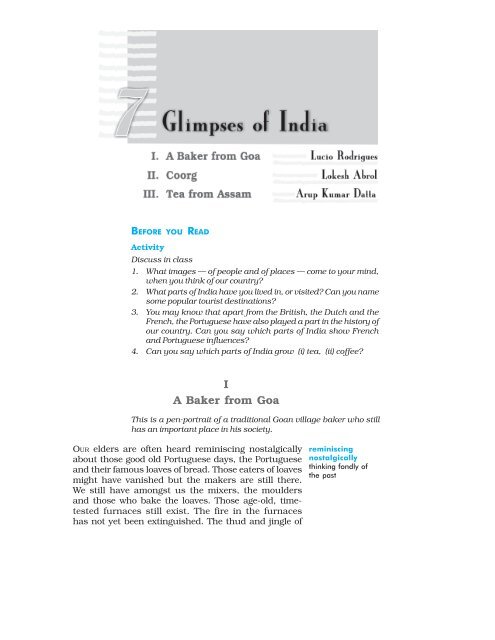
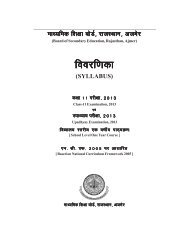

![ek/;fed f'k{kk cksMZ jktLFkku] vtesj - welcome main page ...](https://img.yumpu.com/50500614/1/190x245/ek-fed-fkkk-cksmz-jktlfkku-vtesj-welcome-main-page-.jpg?quality=85)

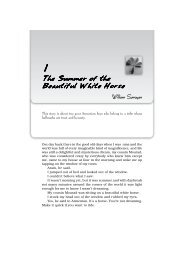

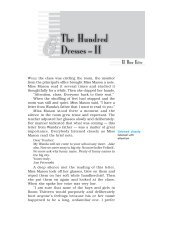
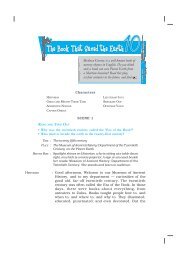
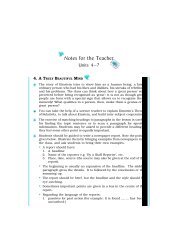
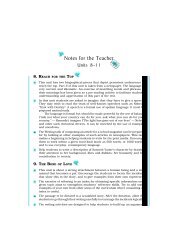

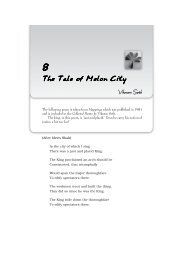

![ek/;fed f'k{kk cksMZ jktL ek/;fed f'k{kk cksMZ jktLFkku] vtesj ksMZ ...](https://img.yumpu.com/36383524/1/190x245/ek-fed-fkkk-cksmz-jktl-ek-fed-fkkk-cksmz-jktlfkku-vtesj-ksmz-.jpg?quality=85)